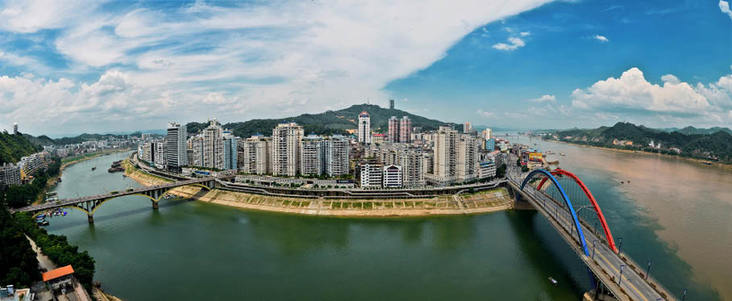Wuzhou: Lingnan’s Most Memorable City
By WU MEILING
The ancient city of Wuzhou is regarded as the cradle of two provinces. Emperor Taizong (993-997) of the Song Dynasty (960-1279) demarcated the area to the east of Wuzhou as Guangdong, and the western area as Guangxi. Today the city is known for its elegant natural scenery and industry as well as its antique culture. It has been recognized as a National Forest City, a world capital of artificial gemstones and a national model for recycling and green energy. Liang Yusheng, a famous Kung Fu novelist, set one of his stories among the spectacular natural wonders of Wuzhou.
 |
|
When the clear Guijiang River meets the turbid Xijiang River, the two distinguishable currents flow for a stretch before fully mixed. This section is locally called the Mandarin Duck River. |
Wuzhou is a city built around rivers, and waterways are at the heart of city life. The Xunjiang and the Guijiang rivers join here to form the Xijiang River, which flows eastward to Guangdong and empties into the South China Sea. With over 4,000 years of civilization and a city over 2,000 years old, Wuzhou stands out as one of China’s most celebrated towns.
The city’s name dates back to the primitive Cangwu tribe under the reign of emperors Yao and Shun. Cangwu was so named for the abundance of Chinese parasol trees (wutong) and their dark green (cang) hue. Historically, Wuzhou was an important trading port on the Maritime Silk Road. Originally called Guangxin County, the area was renamed Cangwu under the Sui Dynasty (581-618) in 583. The name Wuzhou first appeared during the Tang Dynasty (618-907) in 621.
Wuzhou is also famous as the resting place of the legendary Emperor Shun, who died while hunting in the wilderness of Cangwu. Shun ruled China around 2000 BC and united the Yellow River Plain with Lingnan (the area south of the Five Ridges mainly including Guangdong and Guangxi). In his waning years, Shun made an inspection tour of Cangwu and spread the culture of the Central Plains area to the uncivilized territory. However, after many difficult travels, Shun died and was buried in the Baiyun Mountain. His grave has been a celebrated site for literary masters including Li Bai, Du Fu and Su Shi.
Time-Honored Commercial Port
In 221 BC, the first emperor of the Qin Dynasty (221-207 BC) sent 500,000 soldiers to suppress the southern region dominated by the Baiyue people. Benefiting from the Lingqu Canal connecting China’s north and south rivers, the area south of the Five Ridges was soon incorporated into Qin territory. However, one tribe of the Baiyue people, who lived in the area now includingWuzhou, Yulin and Beihai, rose up in revolt. Then the emperor dispatched a troop of 500,000 soldiers to suppress the revolt, and four years later, sent another half million migrants to defend the restless region. The new residents, five fold the original Baiyue people, made the Central Plains culture take root in the region, and as a fusion of Han and the Baiyue native languages, Cantonese came into being.
